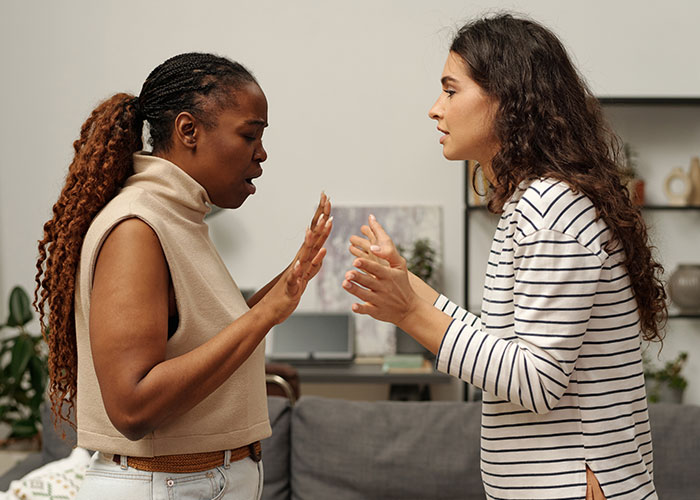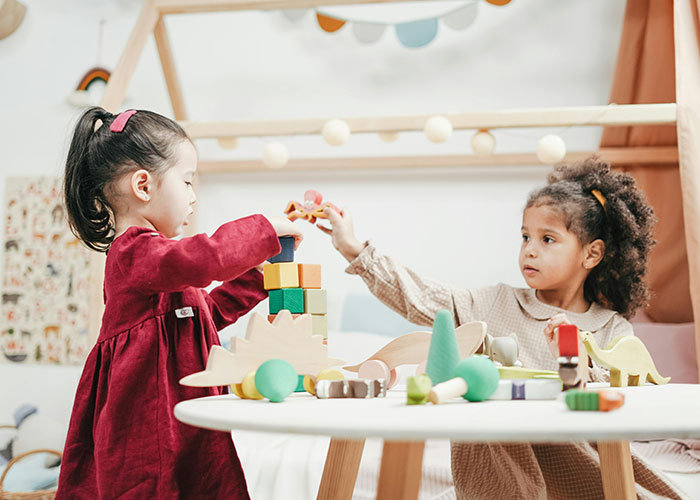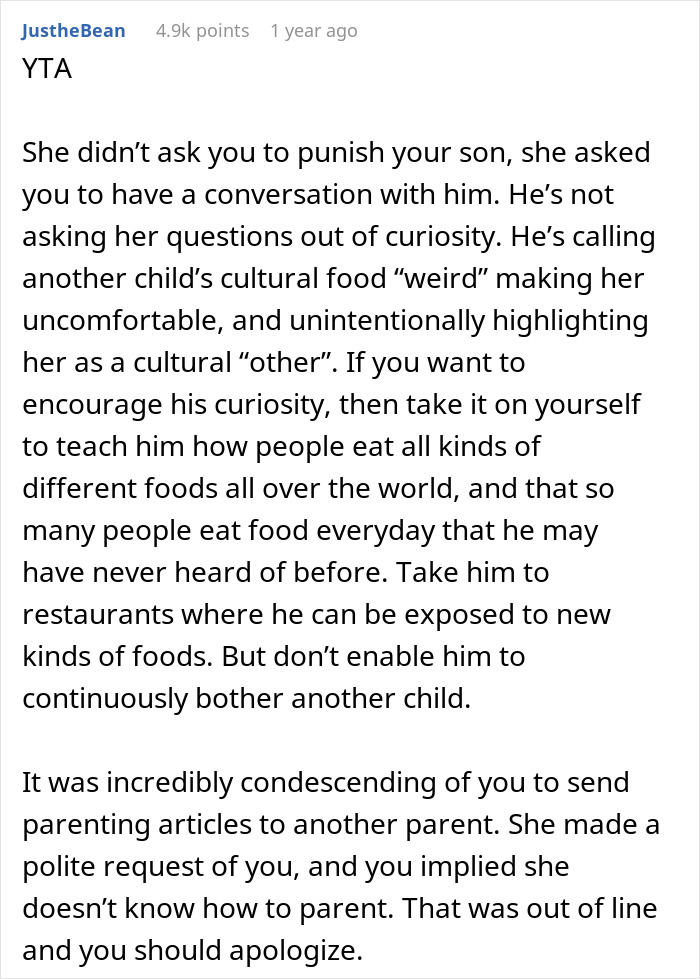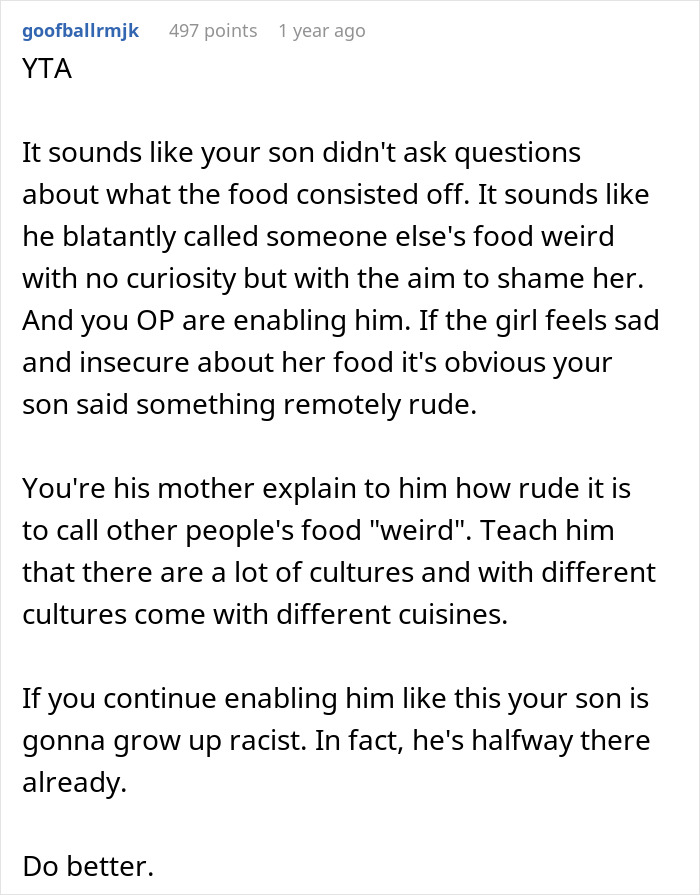
Mother Thinks Her Son Bullying Classmate About Her “Weird” Lunch Is Normal, Gets A Reality Check
Interview With ExpertCultural sensitivity is one of those things we learn by interacting with people. And that starts at an early age: in school. Sadly, some children choose to tease others because of their culture. In fact, research has found that 23% of all bullying cases involve harassment based on race.
This 7-year-old did something similar, albeit not on purpose. He called his classmate’s traditional food ‘weird.’ And when the boy’s mother found out, she didn’t see what the big deal was. That caused an uproar online, with many folks accusing her of racism and inadequate parenting.
Bored Panda sought the expertise of the Associate Professor and the Coordinator of the Social Foundations: Multicultural Education Program Area Dr. Traci Baxley, who’s also a cultural and race identity coach for parents. She explained why it’s important to teach children cultural sensitivity and the best ways parents can do that. Read her thoughts below!
A 7-year-old girl was having her traditional lunch when a classmate made fun of it by calling it ‘weird’
Image credits: monkeybusiness / enavtoelements (not the actual photo)
But the boy’s mom didn’t see anything wrong with his behavior; the girl was just being too sensitive
Image credits: Pressmaster / envatoelements (not the actual photo)
Image credits: throwawaymomlunch
Kids as young as three or four might start noticing cultural differences such as food or customs
Image credits: cottonbro studio / pexels (not the actual photo)
Children start noticing and commenting on cultural differences at a certain age. A toddler probably wouldn’t do that, but a three or four-year-old might. Dr. Traci Baxley says this is perfectly normal behavior, and kids usually start doing it as early as preschool age.
“This is the time in their lives when they begin interacting more with others outside of their immediate family and become more aware of their surroundings,” she explained to Bored Panda. “During this developmental period, open, honest conversations that celebrate diversity and nurture their curiosity are critical.”
For parents who worry they don’t know how to broach the subject, Dr. Baxley has some possible scripts. Parents can say something like: “It’s great to ask questions about what you see and learn. It shows you’re interested in understanding the world around you!”
It’s also important to teach the child to be open-minded and sensitive. Parents might tell them: “Imagine if someone from another country was learning about our traditions for the first time. We’d want them to be curious and respectful, right? Let’s do the same.”
That said, a child has to feel safe to ask questions. The goal is for them to explore and learn without fear, shame, or judgment. “Approach them with understanding and encouragement to support their continuous growth,” Dr. Baxley says, suggesting a possible script: “It’s okay to be curious or unsure about new things. You can always ask questions here, and we’ll find the answers together.”
Parents should expose children to foods from different cultures
Image credits: Tima Miroshnichenko / pexels (not the actual photo)
Some parents might find it hard to explain the concept of cultural differences in a way their kids can understand. According to Dr. Baxley, food can be a fantastic way to start teaching young children about cultural differences.
“It’s something they can see, touch, and taste, making it both relevant and relatable, and since everyone eats, it’s a universal experience. Parents should embrace their kids’ curiosity about the world. When kids notice different foods, customs, or languages, it’s the perfect chance to teach them more about those cultures,” she explains.
“By talking about these differences in a fun and engaging way, encouraging questions, and sharing stories, parents can help their kids understand and appreciate the diversity around them. This doesn’t just teach them new things—it helps them become more respectful and empathetic towards others,” Dr. Baxley says.
She suggests some simple ways parents can go about it:
Choose a recipe to cook together or go to a restaurant from a different culture once a month. Discuss the dish’s origins and the traditional ways it’s prepared and eaten. Compare and contrast the dishes to ones that your family is more familiar with.
Read children’s books from around the world. This can expand children’s understanding and appreciation of different lifestyles and perspectives.
Watch children’s films like Coco (Mexico), Moana (Polynesia), Ratatouille (France), Brave (Scotland) and Encanto (Colombia) that highlight cultural stories. Discuss the culture, landscape, and values portrayed.
If possible, attend cultural festivals in your area. This direct exposure to different cultures through food, music, dance, and crafts can be a rich learning experience. Plus, it’s a great chance to meet people in your extended community.
People in the comments gave the woman a reality check about teaching her son to learn how to respect other cultures
However, some backed the woman, saying the girl needed to grow thicker skin
Poll Question
Thanks! Check out the results:
Explore more of these tags
Its always fun when the AITA poster is so shameless about showing what a p.o.s. they are. Even the ridiculous NTAs had a hard time keeping up with her this time.
One was sarcastic and it's thrown in there like it was a serious NTA.
Load More Replies...When I was a child a new family moved into my school. they were Asian, I don’t know what country they were from. The young girl in my class has some meal that I couldn’t identify, I exclaimed to her, “OMG what is that??:” She looked all defensive until I said, “It smells delicious!:” I had a new friend!
Let me get this right... The OP expected the 7-year-old girl to learn to overcome insecurities in order to accommodate a 7-year-old boy whose mother won't teach him manners. There is a good advice in the comments, such as using different words. If she truly believes that he's curious, she can make differences interesting to him instead of "weird" - such as trying different foods.
I'm just surprised more people haven't said anything about OP having the audacity to send parenting articles to another parent who reached out to her about her son's behaviour. You can disagree with the other parent if that's what you want to do, but I think she showed it why her son feels entitled to act the way he did.
Exactly this! And I noticed she posted no replies to any of the YTA judgments.
Load More Replies...When I was a kid I read a novel called Onion Tears. It was about a young girl from Vietnam who has to move to Australia because of the war. She's hurting inside in all different kinds of ways, missing her home and her pets she had to leave behind. At school, the white kids mercilessly bully her on racial grounds, making fun of her name and also targeting the Vietnamese foods she brings for lunch. It's incredibly sad, but it has a happy ending. Why? Because those kids learn to do better. Because it's not on HER to fix the situation; it's on them and their parents and teachers.
Low life willfully ignorant racists raise their brats to be low life ignorant racists just like themselves.
Amusing how hard people are screaming to insist this isn't about race when it so obviously is. Think it through. The spelling and grammar indicates OP to be American. Only a White person (but not all) in a White-majority country would be oblivious to the exclusion a child would feel being mocked for eating different food. Americans whose families have been there more than one or two generations are pretty accustomed to the gamut of European cuisines (plus a few others), so for a kid to see a "traditional meal" he finds "weird," it would have to be from a culture he hasn't encountered before, which eliminates anything European. I'm guessing the girl is from a small minority South Asian or African culture, because the spice/flavour/scent profiles of those two groups of cuisines (emphasize groups - as in there are countless variations) differ significantly enough from what's available in at Golden Corral or Applebee's to catch the attention of an obnoxious kid whose mother won't parent.
Load More Replies...My sister was 13, First day she was in a new school, she poured her milk into her chocolate pudding, just as she always liked it, a group of 4 girls started calling her names for it telling her she was gross and it discussing to mix food to get her {like what?} and she was nasty for drinking it They did that to her daily for 2 weeks, and she never did it again in school {losing one of the fun things she got} passed that first day but they stayed on calling her names and telling others to stay from her.... No one would be her friend, she couldn't get them to be, or talk to her unless a teacher watched or they got something out of it, But god.... tormenting a 13-14-year-old kid that liked milk in chocolate pudding? What did they think pudding was made of? This was a Problem school...so these were kids flat out cheating, stealing, and some hurt people.... my sis problem? was like the rest of the family and had bad sicknesses and could make it to school a lot so they put her in it
As a parent AND an educator I have to agree with the majority of the YTA comments - and roll my eyes at the "teacher should have been on top of it" in the NTA comment! Yes, I am responsible for your child for a great portion of the day - but for 45 minutes at a time; and 25 children at a time. In addition, my primary goal is to educate the students, maintain classroom decorum. I need to presume BASIC principles of human behavior are taught at home so that I only need to reinforce them in the classroom. In this particular instance the victim's mother attempted to resolve the bullying of her child by reaching out to the responsible parent. Presumably she HAS spoken to her child about prejudice and the poor behavior of others. It is unfortunate that the bullying child's mother did not see the future ramifications of her child's (and her own) behavior.....which will only come to fruition.
This story needs a looooot more details. The kid may have been trying to be offensive or not, I don't know. When you see something for the first time it's normal to think it's "weird". I lived in different countries and I've seen a lot of really weird (from my point of view, obvious) food, and I didn't say anything, but I'm sure my face showed what I was thinking. Or perhaps he was trying to be offensive. It's difficult to know. The key point is the mother must actually *parent* her child and teach him about cultural differences and how to be respectful of other people's choices. What about teaching him "if you have nothing good to say, say nothing"? It's usually a good approach to "weird" situations. These days, I know asking a parent to actually parent their child is a totally revolutionary concept, but that's their job. Instead of being so worried about marks they should focus on raising decent human beings.
It’s true that maybe he wasn’t trying to be offensive- kids that age can sometimes struggle to say what they really mean and might default to using words like ‘weird’, when they really mean it in a more positive way (weird in a cool way). But even if that was the case, once the other parent reached out to her, the mother should have still talked to her son and find new ways for him to express his curiousity.
Load More Replies...Anyone telling this trash mom she is NTA is an absolute garbage human, she is a s**t parent raising a s**t kid who is a bully. The audacity telling that m other she found some online parenting classes for building confidence so she can give her kid tips, WTF? The OP is in desperate need of parenting classes, wow, what an insufferable C word..
Its always fun when the AITA poster is so shameless about showing what a p.o.s. they are. Even the ridiculous NTAs had a hard time keeping up with her this time.
One was sarcastic and it's thrown in there like it was a serious NTA.
Load More Replies...When I was a child a new family moved into my school. they were Asian, I don’t know what country they were from. The young girl in my class has some meal that I couldn’t identify, I exclaimed to her, “OMG what is that??:” She looked all defensive until I said, “It smells delicious!:” I had a new friend!
Let me get this right... The OP expected the 7-year-old girl to learn to overcome insecurities in order to accommodate a 7-year-old boy whose mother won't teach him manners. There is a good advice in the comments, such as using different words. If she truly believes that he's curious, she can make differences interesting to him instead of "weird" - such as trying different foods.
I'm just surprised more people haven't said anything about OP having the audacity to send parenting articles to another parent who reached out to her about her son's behaviour. You can disagree with the other parent if that's what you want to do, but I think she showed it why her son feels entitled to act the way he did.
Exactly this! And I noticed she posted no replies to any of the YTA judgments.
Load More Replies...When I was a kid I read a novel called Onion Tears. It was about a young girl from Vietnam who has to move to Australia because of the war. She's hurting inside in all different kinds of ways, missing her home and her pets she had to leave behind. At school, the white kids mercilessly bully her on racial grounds, making fun of her name and also targeting the Vietnamese foods she brings for lunch. It's incredibly sad, but it has a happy ending. Why? Because those kids learn to do better. Because it's not on HER to fix the situation; it's on them and their parents and teachers.
Low life willfully ignorant racists raise their brats to be low life ignorant racists just like themselves.
Amusing how hard people are screaming to insist this isn't about race when it so obviously is. Think it through. The spelling and grammar indicates OP to be American. Only a White person (but not all) in a White-majority country would be oblivious to the exclusion a child would feel being mocked for eating different food. Americans whose families have been there more than one or two generations are pretty accustomed to the gamut of European cuisines (plus a few others), so for a kid to see a "traditional meal" he finds "weird," it would have to be from a culture he hasn't encountered before, which eliminates anything European. I'm guessing the girl is from a small minority South Asian or African culture, because the spice/flavour/scent profiles of those two groups of cuisines (emphasize groups - as in there are countless variations) differ significantly enough from what's available in at Golden Corral or Applebee's to catch the attention of an obnoxious kid whose mother won't parent.
Load More Replies...My sister was 13, First day she was in a new school, she poured her milk into her chocolate pudding, just as she always liked it, a group of 4 girls started calling her names for it telling her she was gross and it discussing to mix food to get her {like what?} and she was nasty for drinking it They did that to her daily for 2 weeks, and she never did it again in school {losing one of the fun things she got} passed that first day but they stayed on calling her names and telling others to stay from her.... No one would be her friend, she couldn't get them to be, or talk to her unless a teacher watched or they got something out of it, But god.... tormenting a 13-14-year-old kid that liked milk in chocolate pudding? What did they think pudding was made of? This was a Problem school...so these were kids flat out cheating, stealing, and some hurt people.... my sis problem? was like the rest of the family and had bad sicknesses and could make it to school a lot so they put her in it
As a parent AND an educator I have to agree with the majority of the YTA comments - and roll my eyes at the "teacher should have been on top of it" in the NTA comment! Yes, I am responsible for your child for a great portion of the day - but for 45 minutes at a time; and 25 children at a time. In addition, my primary goal is to educate the students, maintain classroom decorum. I need to presume BASIC principles of human behavior are taught at home so that I only need to reinforce them in the classroom. In this particular instance the victim's mother attempted to resolve the bullying of her child by reaching out to the responsible parent. Presumably she HAS spoken to her child about prejudice and the poor behavior of others. It is unfortunate that the bullying child's mother did not see the future ramifications of her child's (and her own) behavior.....which will only come to fruition.
This story needs a looooot more details. The kid may have been trying to be offensive or not, I don't know. When you see something for the first time it's normal to think it's "weird". I lived in different countries and I've seen a lot of really weird (from my point of view, obvious) food, and I didn't say anything, but I'm sure my face showed what I was thinking. Or perhaps he was trying to be offensive. It's difficult to know. The key point is the mother must actually *parent* her child and teach him about cultural differences and how to be respectful of other people's choices. What about teaching him "if you have nothing good to say, say nothing"? It's usually a good approach to "weird" situations. These days, I know asking a parent to actually parent their child is a totally revolutionary concept, but that's their job. Instead of being so worried about marks they should focus on raising decent human beings.
It’s true that maybe he wasn’t trying to be offensive- kids that age can sometimes struggle to say what they really mean and might default to using words like ‘weird’, when they really mean it in a more positive way (weird in a cool way). But even if that was the case, once the other parent reached out to her, the mother should have still talked to her son and find new ways for him to express his curiousity.
Load More Replies...Anyone telling this trash mom she is NTA is an absolute garbage human, she is a s**t parent raising a s**t kid who is a bully. The audacity telling that m other she found some online parenting classes for building confidence so she can give her kid tips, WTF? The OP is in desperate need of parenting classes, wow, what an insufferable C word..

 Dark Mode
Dark Mode 

 No fees, cancel anytime
No fees, cancel anytime 

























































































41
60